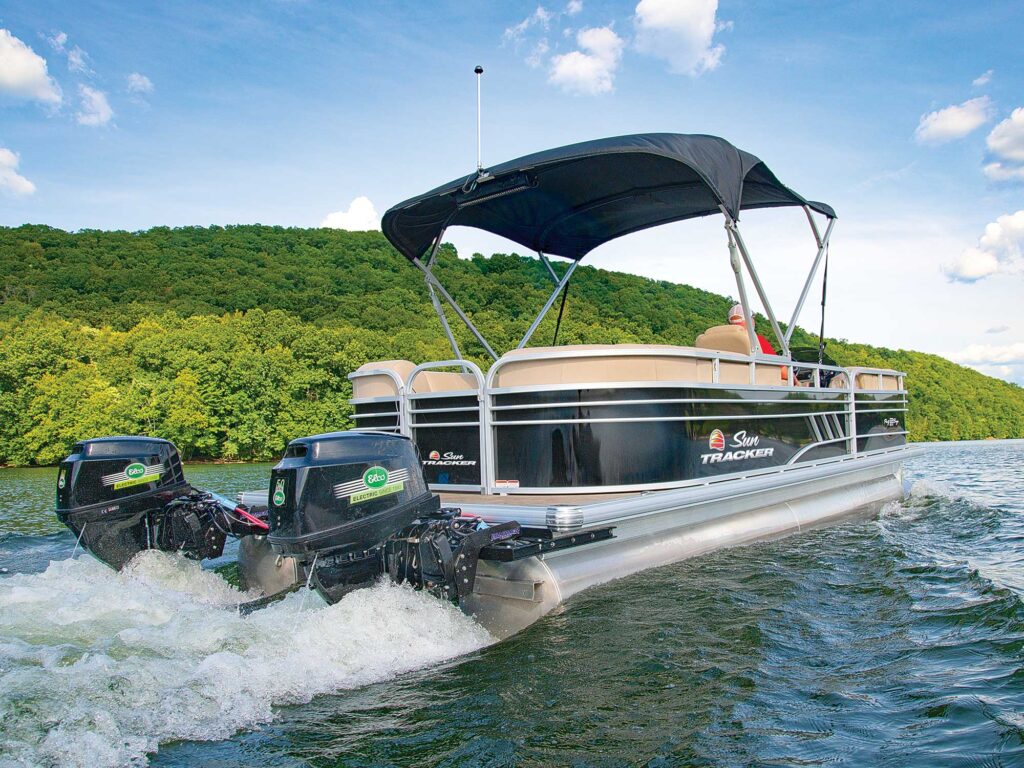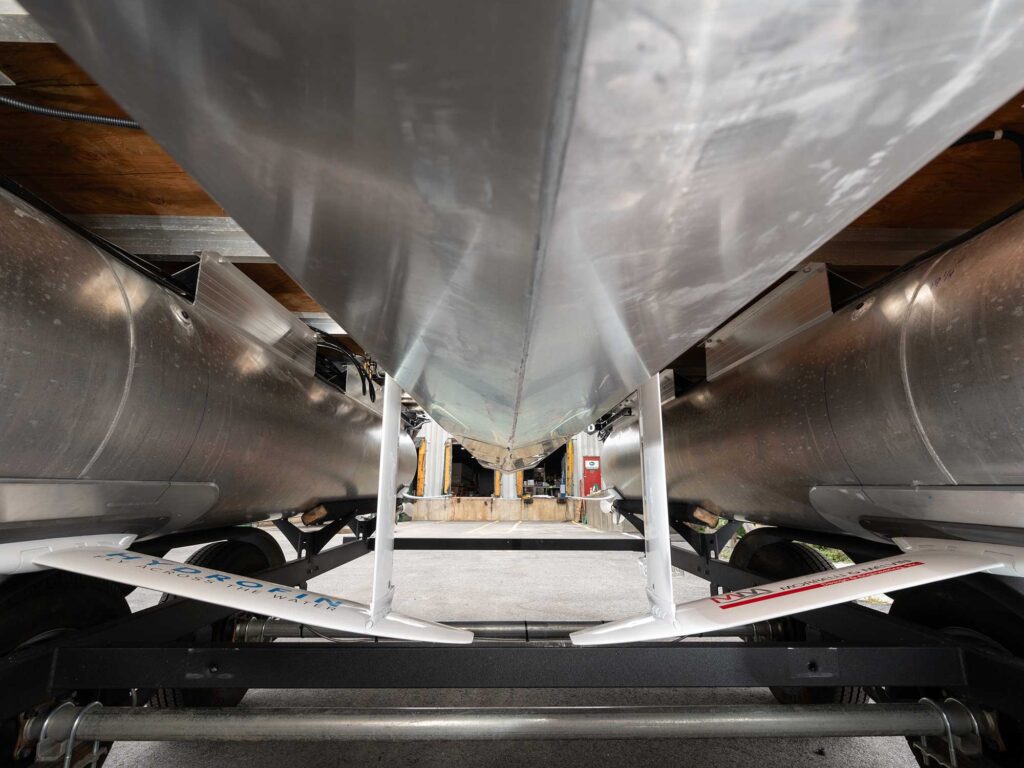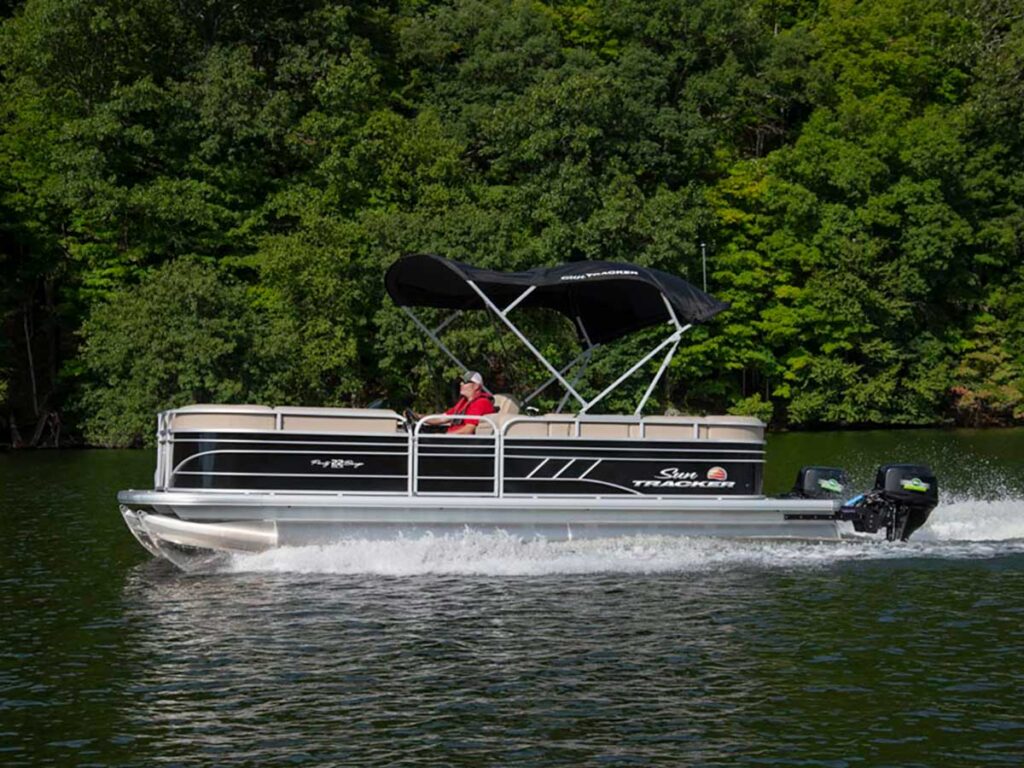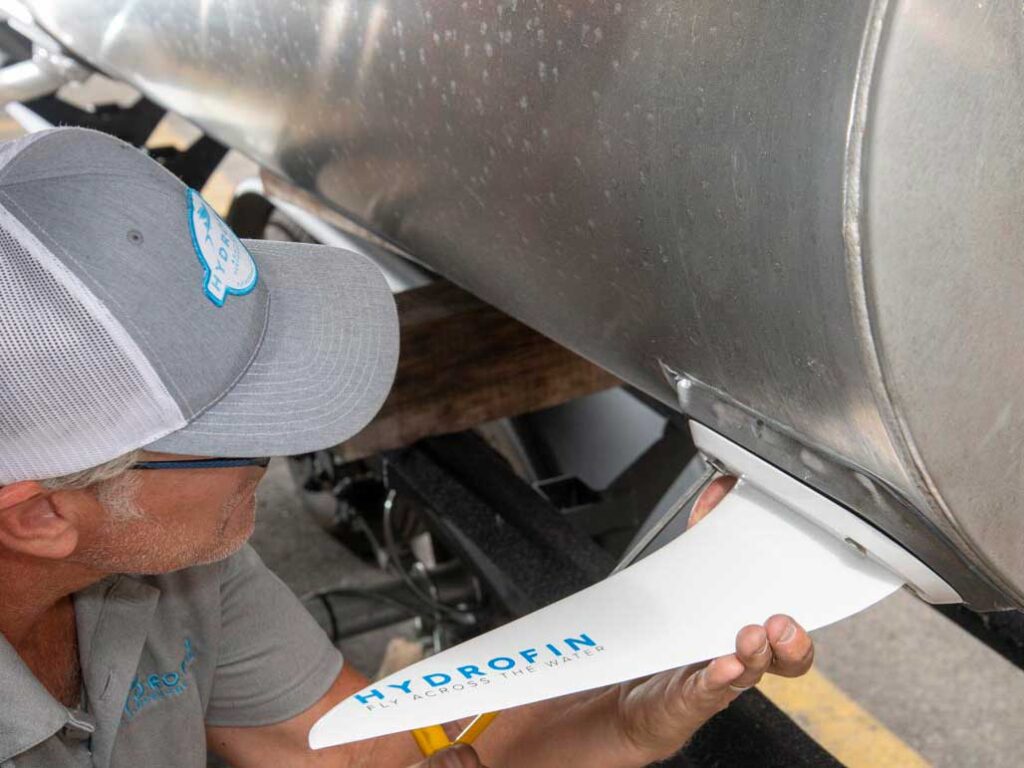SB Television
Using Hydrofoils to Improve Boat Performance
 Hydrofin foils generate lift equivalent to about half the boat’s weight, greatly enhancing efficiency.
Capt. Vincent Daniello
Hydrofin foils generate lift equivalent to about half the boat’s weight, greatly enhancing efficiency.
Capt. Vincent Daniello
In my early days as a captain, few boats cruised faster than 30 mph. Back then, bigger engines and the fuel they burned added too much weight, netting little more speed. Today, even modest performers top 50 mph thanks to lighter engines and boat construction, where more ponies push fewer pounds.
Electric propulsion leaves boats yet again struggling in that extra-pounds paradigm. Adding fuel—
measured in kilowatt-hours of lithium batteries—attenuates attempts to go faster and farther, at least until batteries become lighter. But there might be another way. I tested an electric-powered SunTracker Party Barge 22 DLX both before and after Hydrofin installed its hydrofoil system, which lifts a boat while moving through the water. This effectively overcame 800 pounds of lithium iron phosphate (LiFePO4) batteries—40 kilowatt-hours—that fueled twin Elco EP-50 electric outboards. In the end, flying on foils increased the boat’s speed by well more than a third and improved efficiency markedly. So, what are hydrofoils, and can they enhance performance aboard other boats too?
 The foils add about 4 inches to the draft of the boat, though aft of amidships, where beaching shouldn’t be affected. They are designed to break away during a hard strike.
Capt. Vincent Daniello
Performance Takes Flight
The foils add about 4 inches to the draft of the boat, though aft of amidships, where beaching shouldn’t be affected. They are designed to break away during a hard strike.
Capt. Vincent Daniello
Performance Takes Flight
“We’re a long way from batteries that provide lightweight energy. Our hydrofoils create lift to overcome that additional weight,” says Jason Minor, Hydrofin’s founder. The patented system, engineered by noted catamaran and America’s Cup sailing foil-design firm Morrelli & Melvin of Newport Beach, California, utilizes powder-coated aluminum foils—essentially underwater wings. Mounting pads epoxied to hulls allow incremental adjustment of location and angle of attack, so Hydrofin foils lift nearly half a boat’s weight. “A typical bi-toon with a gas 150 runs around 30 mph. Adding Hydrofin foils can easily make it run 37 to 39 mph,” Minor says, adding that 30 percent better economy is common at cruising speeds. Riding higher on wings makes boats run smoother, dryer and quieter too. (See our Hydrofin test on a Misty Harbor 2528 pontoon with a Merc 150 hp gas outboard at boatingmag.com/hydrofin.)
Put to the TestHydrofin foils lifted so much battery weight that our Elco-powered test boat required larger propellers to see full improvement. Comparing performance from the final propellers, with foils removed, the boat reached 17.2 mph turning just 5,400 rpm and drawing an overloaded 67.2 kW. With Hydrofin foils installed, those same props turned 5,750 rpm to reach 24.9 mph at 58.56 kW. The original propellers, without hydrofoils, reached 6,000 rpm and 17.9 mph while consuming 49.06 kW, which we used to compute 39 percent increased speed and 16 percent improved efficiency with hydrofoils installed.
 The Hydrofin foils added 7 mph top speed and increased efficiency by 16 percent aboard this 22-foot SunTracker with twin Elco EP-50 electric motors.
Capt. Vincent Daniello
Worth the Weight
The Hydrofin foils added 7 mph top speed and increased efficiency by 16 percent aboard this 22-foot SunTracker with twin Elco EP-50 electric motors.
Capt. Vincent Daniello
Worth the Weight
Minor says that about one-third of installations benefit from new props, which is expected when essentially lightening a boat by half. Those underwater wings alleviate passenger weight too, which often impacts gas-powered pontoon boatspeed. “A boat might lose 6 or 8 mph when full of people,” Minor says, versus carrying minimal crew. “That same boat would see just a 2 or 3 mph drop with our hydrofoils installed.”
Tri-toons, with lift from a third hull and planing strakes, tend to benefit a bit less. Minor says that gas tri-toons typically see 15 to 25 percent increase in speed or fuel economy. On a 25-foot Qwest Tri-toon powered with a prototype 350 hp equivalent Hyper Electric outboard and 1,150 pounds of batteries, Minor reported that the boat gained from 15 percent to 29 percent efficiency in the 20 to 35 mph cruising range. Hydrofin foils proved 7 percent more efficient at 43 mph, which was wide-open throttle without the foils, and they added 6 mph top speed, reaching 49 mph at the same 270 kW. (See our test of the Hyper Electric in Motorhead on page 74.)
Foil DownsidesWhile Minor was installing the Elco-powered test boat’s foils—about a half-day procedure—I kept an eye out for pitfalls. Foils increase draft by about 4 inches, but they’re mounted well aft of amidships, where they shouldn’t interfere at most beaches. Modifying the boat trailer’s inner bunk impacted aligning the boat back onto the trailer at the ramp, but this can be easily remedied with side guide pipes common on monohull trailers. In a hard grounding or collision, foils are engineered to break away, and Minor reports no damage to hulls or mounting pads, only foils themselves, in the few times it has occurred. Operating in very shallow water would surely be problematic, but Hydrofin’s optional electric-actuated system fully retracts well above a pontoon’s bottom.
Other BoatsHydrofin’s system adapts to nearly all pontoon and tri-toon boats, and they’ll work on small power catamarans but not monohulls. “The foils need a gap away from the hull,” Minor explains, which comes when they’re mounted between two hulls. Hydrofin’s foils also won’t work past about 55 mph, when water flow causes foil cavitation.
Long-standing wisdom maintains that more ponies pushing fewer pounds increases speed. That’s still true, but Hydrofin shows that boats can also grow wings and fly.
 Hydrofin hydrofoils use mounting pads for installation.
Capt. Vincent Daniello
How Hydrofin Foils Attach to the Hull
Hydrofin hydrofoils use mounting pads for installation.
Capt. Vincent Daniello
How Hydrofin Foils Attach to the Hull
On twin-hull boats, Hydrofin hydrofoils mount to pads epoxied to hulls between pontoons, with braces extending upward to the deck. Foil location and angle of attack adjust fore-and-aft trim and total lift. Finlets mounted aft add more lift to further tweak the boat’s ride and trim.
Oversize fins, chosen to carry battery weight, range from 343 to 1,822 pounds lift at 25 mph.
Tri-toons utilize a modified mount and fins that create from 537 to 1,021 pounds of lift at 25 mph, where a 25-foot Qwest tri-toon with Hyper Electric Marine’s 350 hp electric outboard was 29 percent more efficient with Hydrofin foils installed, while top speed increased by 6 mph, according to Hydrofin.
The post Using Hydrofoils to Improve Boat Performance appeared first on Boating Mag.
- Home
- About Us
- Write For Us / Submit Content
- Advertising And Affiliates
- Feeds And Syndication
- Contact Us
- Login
- Privacy
All Rights Reserved. Copyright , Central Coast Communications, Inc.